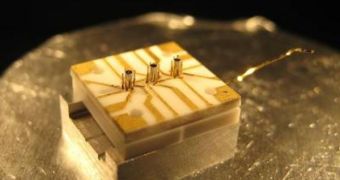Ion traps haven't been a thing of novelty for a very long time, ever since they started being used regularly in atomic clocks, as well as in lines of research related to quantum computing development. Ions, which are essentially electrically charged atoms, move through these so-called traps, and experience all sorts of alterations, which are needed for whatever purpose they are serving. Thanks to a new study done by experts at the National Institute of Standards and Technology (NIST), scientists could soon use a new ion trap architecture to efficiently transfer individual light particles (photons) in quantum communications, or even for sensing very small forces, acting at the nanoscale.
The NIST researchers, which worked together with colleagues from the University of Erlangen-Nuremberg, in Germany, for the new research, say that their new ion trap can be likened to a stylus trap, and that it is significantly different from other ion traps in the fact that it does not use electrodes to surround the trapped ions, but rather places a single ion on top of a tip made of electrodes. This fact, coupled with the open design of the trap, allows unprecedented amounts of access to the ion being tested or otherwise acted upon.
The new construct, with the ion trapped on it acting like a probe, is about one million times more sensitive to small forces than atomic force microscopes, which use cantilevers as probes. This happens because the ion has a much smaller mass, which makes it more susceptible to outside influences. Additionally, unlike atoms and quantum dots, ions are considerably more prone to detecting subtle variations not only in the electric field it analyzes, but also in the magnetic field as well, and in other types of forces too.
Conversely, the ion could be placed under a con-shaped mirror, which could then concentrate light on it with great accuracy. The photons hitting it could transfer from the optical fiber to the single ion, with an efficiency of almost 95 percent, the team also reports. Such a trait could be useful for constructing devices related to long-distance quantum key cryptography (QKD). Furthermore, the natural glow that such ions have could be collected by sensitive detectors, and passed out of a quantum computer as a data output channel.

 14 DAY TRIAL //
14 DAY TRIAL //